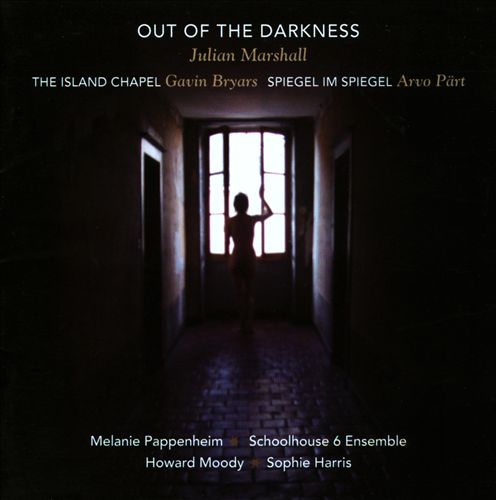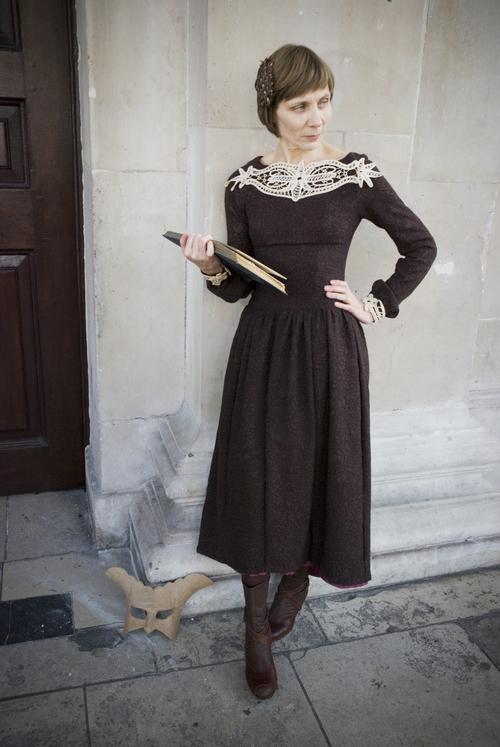April, 2010
Julian Marshall: Out of the Darkness
Notes & Reviews
Soundcloud
“Julian Marshall’s Chamber Cantata, Out of the Darkness, has a mysterious tone from the outset. The opening Prologue alternates between unison chant-style lines and open and dissonant harmonies which rarely resolve, creating a sense of foreboding. The title comes from a poem by Gertrud Kolmar, who lost her life in Auschwitz. The music is scored for chamber choir, mezzo-soprano and a pair of cellos. It uses a range of styles, from dissonant, twisting melodic lines to lighter styles, including tango, which features heavily in the second movement (entitled One). The accompanying cellos are highly effective, giving a variety of textures and a wonderful timbre. The style of singing on this recording verges towards folk rather than classical. The sound is less blended than choral music often is and gives a particular effect. This seems less polished but more emotionally raw. There is a distinct human element that comes through and this reaches out to the listener. This is a work which has impact on an emotional level. The Island Chapel by Gavin Bryars was composed for a performance in St Nicholas Chapel in St Ives: a small chapel which is in an isolated situation overlooking the sea. It makes reference to the Tate St Ives, who commissioned the work, and to paintings by James Hugonin which are hung in the chapel and in the gallery. Exploring the relationships between these elements it is conceived for a performance in a space which would accommodate six audience members. This is an intimate work which combines a chamber-music style closeness with a sense of space and of the outdoors including the expansive distances of the sea reaching out to the horizon. The small forces (keyboard, often holding long drones, cello and mezzo) are highly effective, recorded here with musicians who have a real affinity for the music. Melanie Pappenheim’s uncomplicated voice is particularly effective, imparting purity, and occupying its own acoustic space within the ensemble. The richness of the Sophie Harris’s cello adds a hint of luxury, while the keyboard provides a subtle backdrop for the action, giving a gentle atmosphere with string-like held chords. This is another emotionally strong piece, which sits well next to Marshall’s cantata.
Pärt’s Spiegel im Spiegelwas originally written for violin and piano, but has since been performed in many versions, including for bass clarinet, alto flute, horn, viola, percussion and this version for cello. Its genius lies in its simplicity, creating the effect of a meditation on sound, which transports the listener into another realm. This recording is beautiful, with just the right amount of vibrato in the cello to keep the sound alive but without interrupting the line. Being ultra-critical, the piano is a tiny bit too loud in the balance for my taste, but that is a small point. I could listen to this for hours.”
- Carla Rees
“Julian Marshall’s Chamber Cantata, Out of the Darkness, has a mysterious tone from the outset. The opening Prologue alternates between unison chant-style lines and open and dissonant harmonies which rarely resolve, creating a sense of foreboding. The title comes from a poem by Gertrud Kolmar, who lost her life in Auschwitz. The music is scored for chamber choir, mezzo-soprano and a pair of cellos. It uses a range of styles, from dissonant, twisting melodic lines to lighter styles, including tango, which features heavily in the second movement (entitled One). The accompanying cellos are highly effective, giving a variety of textures and a wonderful timbre. The style of singing on this recording verges towards folk rather than classical. The sound is less blended than choral music often is and gives a particular effect. This seems less polished but more emotionally raw. There is a distinct human element that comes through and this reaches out to the listener. This is a work which has impact on an emotional level. The Island Chapel by Gavin Bryars was composed for a performance in St Nicholas Chapel in St Ives: a small chapel which is in an isolated situation overlooking the sea. It makes reference to the Tate St Ives, who commissioned the work, and to paintings by James Hugonin which are hung in the chapel and in the gallery. Exploring the relationships between these elements it is conceived for a performance in a space which would accommodate six audience members. This is an intimate work which combines a chamber-music style closeness with a sense of space and of the outdoors including the expansive distances of the sea reaching out to the horizon. The small forces (keyboard, often holding long drones, cello and mezzo) are highly effective, recorded here with musicians who have a real affinity for the music. Melanie Pappenheim’s uncomplicated voice is particularly effective, imparting purity, and occupying its own acoustic space within the ensemble. The richness of the Sophie Harris’s cello adds a hint of luxury, while the keyboard provides a subtle backdrop for the action, giving a gentle atmosphere with string-like held chords. This is another emotionally strong piece, which sits well next to Marshall’s cantata.
Pärt’s Spiegel im Spiegelwas originally written for violin and piano, but has since been performed in many versions, including for bass clarinet, alto flute, horn, viola, percussion and this version for cello. Its genius lies in its simplicity, creating the effect of a meditation on sound, which transports the listener into another realm. This recording is beautiful, with just the right amount of vibrato in the cello to keep the sound alive but without interrupting the line. Being ultra-critical, the piano is a tiny bit too loud in the balance for my taste, but that is a small point. I could listen to this for hours.”
- Carla Rees

